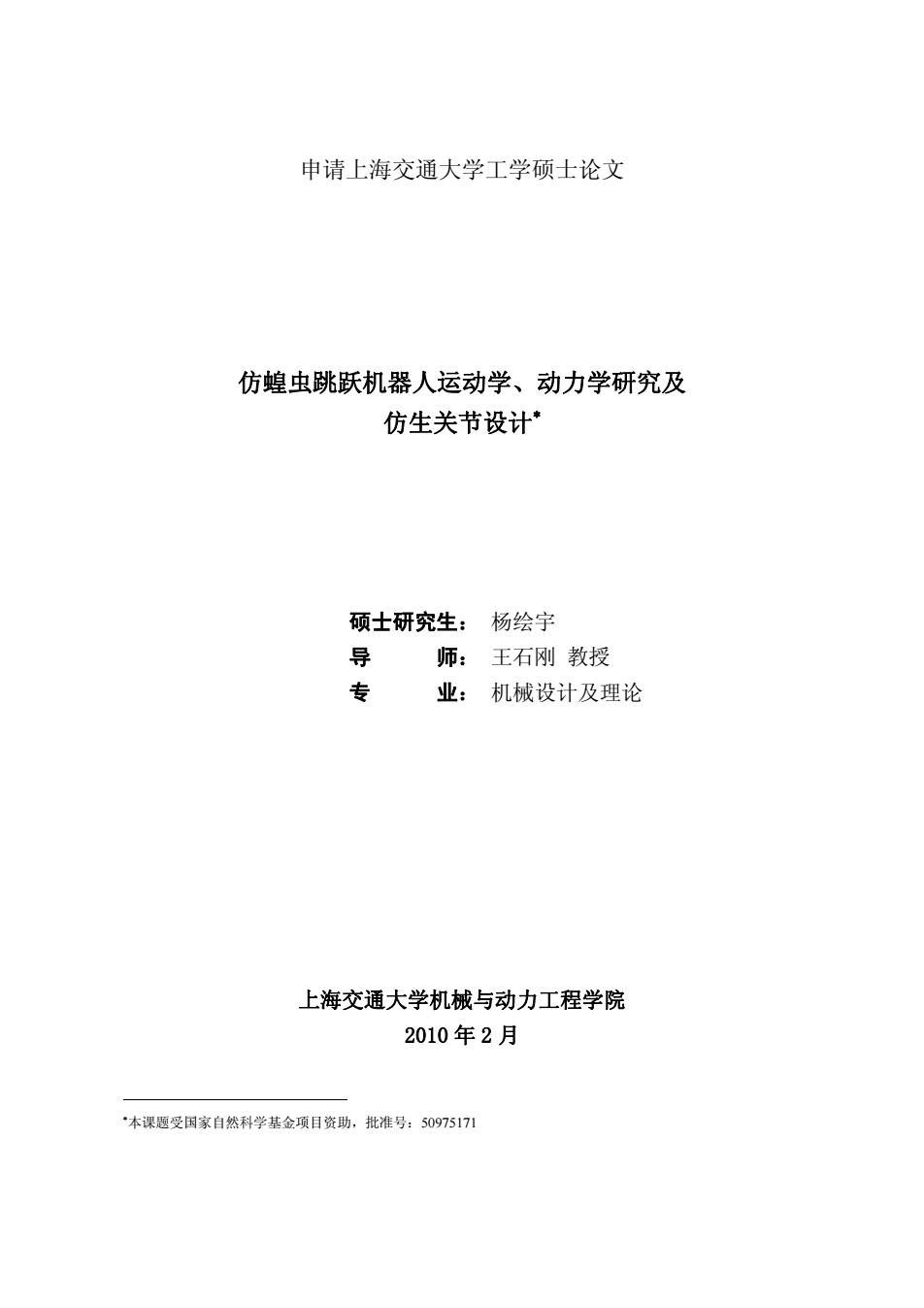
申请上海交通大学工学硕士论文 仿蝗虫跳跃机器人运动学、动力学研究及 仿生关节设计* 硕士研究生: 杨绘宇 导 师: 王石刚教授 专 业:机械设计及理论 上海交通大学机械与动力工程学院 2010年2月 “本课题受国家自然科学基金项日资助,批准号:50975171
申请上海交通大学工学硕士论文 仿蝗虫跳跃机器人运动学、动力学研究及 仿生关节设计∗ 硕士研究生: 杨绘宇 导 师: 王石刚 教授 专 业: 机械设计及理论 上海交通大学机械与动力工程学院 2010 年 2 月 ∗ 本课题受国家自然科学基金项目资助,批准号:50975171
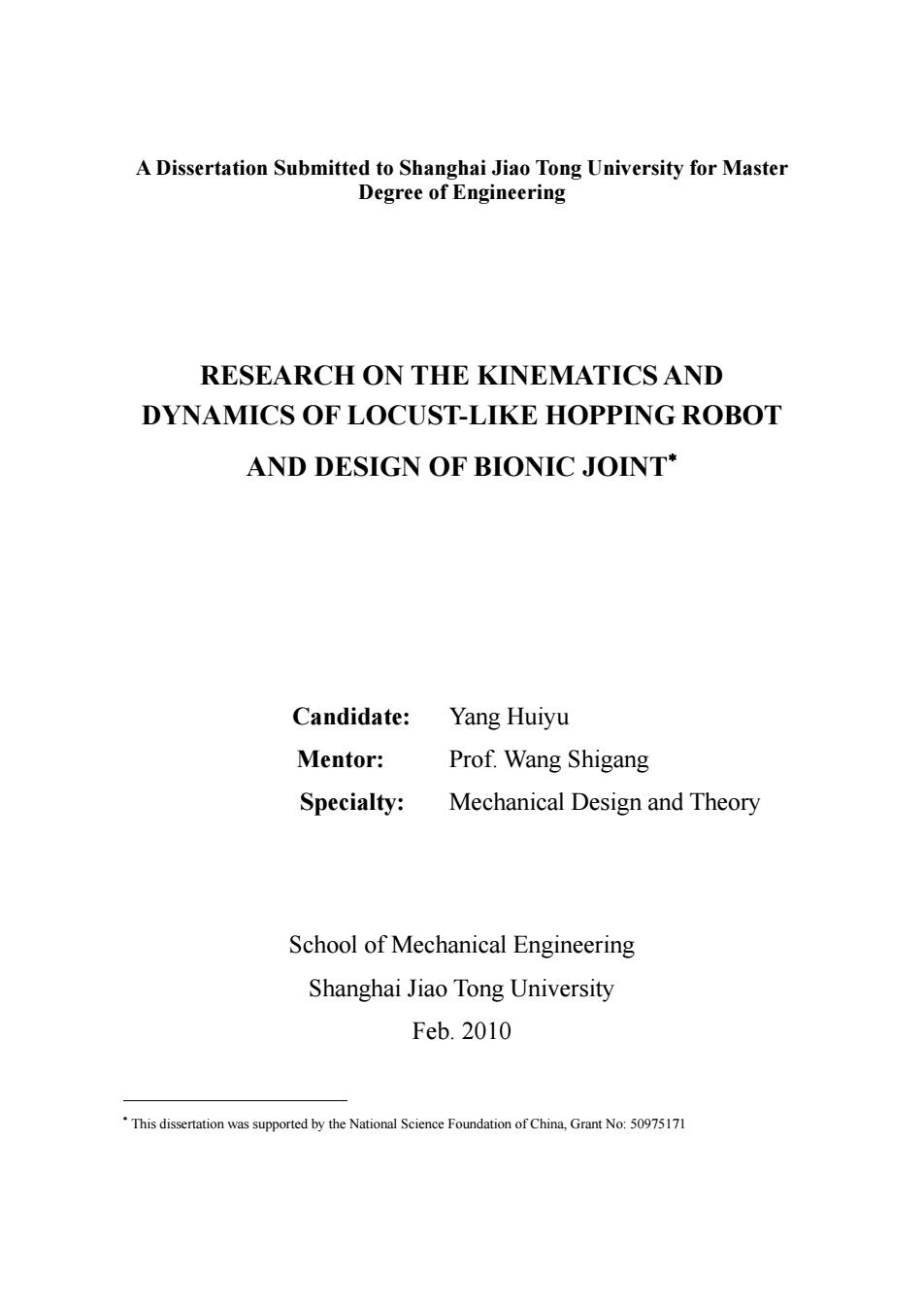
A Dissertation Submitted to Shanghai Jiao Tong University for Master Degree of Engineering RESEARCH ON THE KINEMATICS AND DYNAMICS OF LOCUST-LIKE HOPPING ROBOT AND DESIGN OF BIONIC JOINT* Candidate: Yang Huiyu Mentor: Prof.Wang Shigang Specialty: Mechanical Design and Theory School of Mechanical Engineering Shanghai Jiao Tong University Feb.2010 This dissertation was supported by the National Science Foundation of China,Grant No:50975171
A Dissertation Submitted to Shanghai Jiao Tong University for Master Degree of Engineering RESEARCH ON THE KINEMATICS AND DYNAMICS OF LOCUST-LIKE HOPPING ROBOT AND DESIGN OF BIONIC JOINT∗ Candidate: Yang Huiyu Mentor: Prof. Wang Shigang Specialty: Mechanical Design and Theory School of Mechanical Engineering Shanghai Jiao Tong University Feb. 2010 ∗ This dissertation was supported by the National Science Foundation of China, Grant No: 50975171
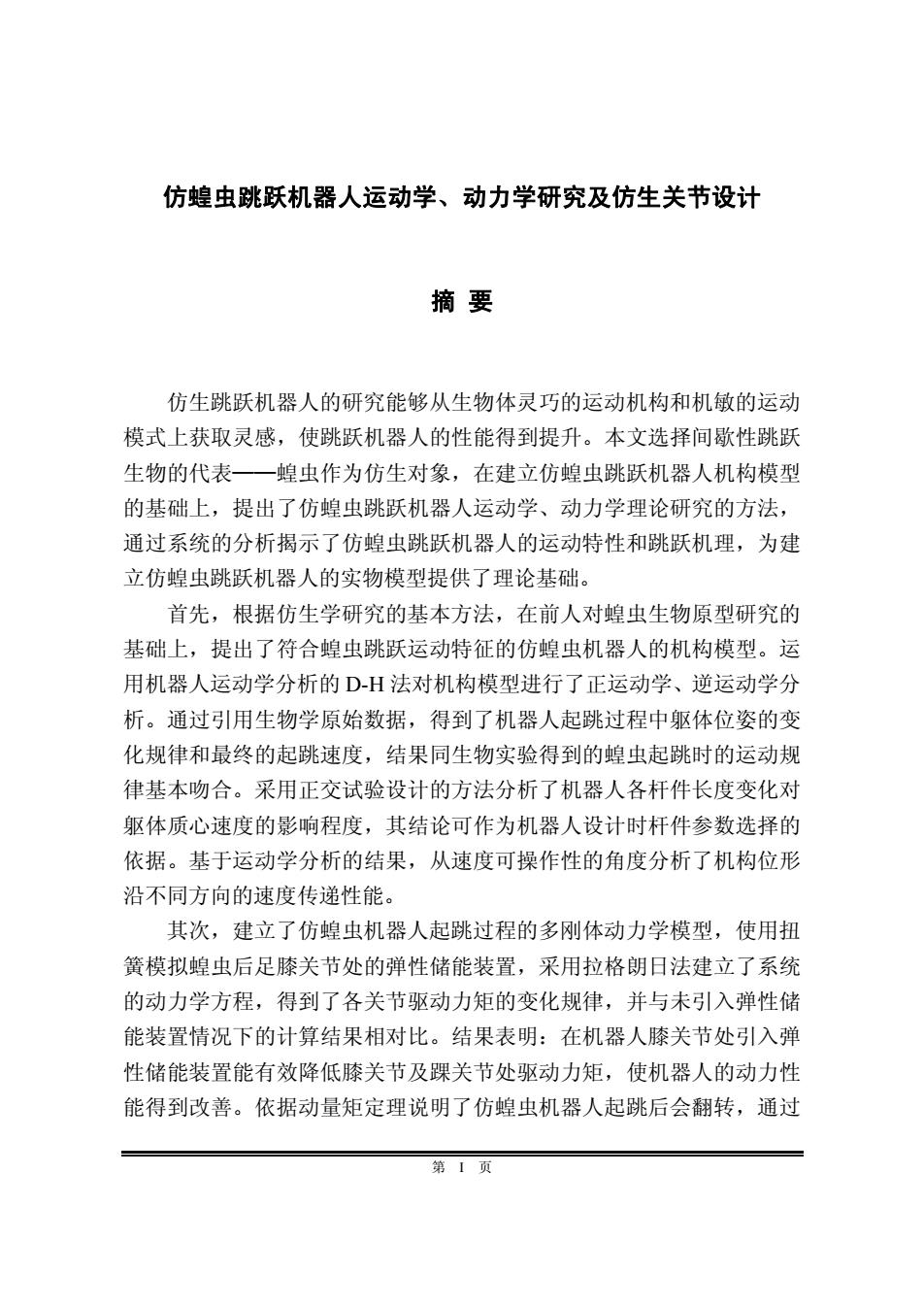
仿蝗虫跳跃机器人运动学、动力学研究及仿生关节设计 摘要 仿生跳跃机器人的研究能够从生物体灵巧的运动机构和机敏的运动 模式上获取灵感,使跳跃机器人的性能得到提升。本文选择间歇性跳跃 生物的代表一一蝗虫作为仿生对象,在建立仿蝗虫跳跃机器人机构模型 的基础上,提出了仿蝗虫跳跃机器人运动学、动力学理论研究的方法, 通过系统的分析揭示了仿蝗虫跳跃机器人的运动特性和跳跃机理,为建 立仿蝗虫跳跃机器人的实物模型提供了理论基础。 首先,根据仿生学研究的基本方法,在前人对蝗虫生物原型研究的 基础上,提出了符合蝗虫跳跃运动特征的仿蝗虫机器人的机构模型。运 用机器人运动学分析的D-H法对机构模型进行了正运动学、逆运动学分 析。通过引用生物学原始数据,得到了机器人起跳过程中躯体位姿的变 化规律和最终的起跳速度,结果同生物实验得到的蝗虫起跳时的运动规 律基本吻合。采用正交试验设计的方法分析了机器人各杆件长度变化对 躯体质心速度的影响程度,其结论可作为机器人设计时杆件参数选择的 依据。基于运动学分析的结果,从速度可操作性的角度分析了机构位形 沿不同方向的速度传递性能。 其次,建立了仿蝗虫机器人起跳过程的多刚体动力学模型,使用扭 簧模拟蝗虫后足膝关节处的弹性储能装置,采用拉格朗日法建立了系统 的动力学方程,得到了各关节驱动力矩的变化规律,并与未引入弹性储 能装置情况下的计算结果相对比。结果表明:在机器人膝关节处引入弹 性储能装置能有效降低膝关节及踝关节处驱动力矩,使机器人的动力性 能得到改善。依据动量矩定理说明了仿蝗虫机器人起跳后会翻转,通过 第I页
第 I 页 仿蝗虫跳跃机器人运动学、动力学研究及仿生关节设计 摘 要 仿生跳跃机器人的研究能够从生物体灵巧的运动机构和机敏的运动 模式上获取灵感,使跳跃机器人的性能得到提升。本文选择间歇性跳跃 生物的代表——蝗虫作为仿生对象,在建立仿蝗虫跳跃机器人机构模型 的基础上,提出了仿蝗虫跳跃机器人运动学、动力学理论研究的方法, 通过系统的分析揭示了仿蝗虫跳跃机器人的运动特性和跳跃机理,为建 立仿蝗虫跳跃机器人的实物模型提供了理论基础。 首先,根据仿生学研究的基本方法,在前人对蝗虫生物原型研究的 基础上,提出了符合蝗虫跳跃运动特征的仿蝗虫机器人的机构模型。运 用机器人运动学分析的 D-H 法对机构模型进行了正运动学、逆运动学分 析。通过引用生物学原始数据,得到了机器人起跳过程中躯体位姿的变 化规律和最终的起跳速度,结果同生物实验得到的蝗虫起跳时的运动规 律基本吻合。采用正交试验设计的方法分析了机器人各杆件长度变化对 躯体质心速度的影响程度,其结论可作为机器人设计时杆件参数选择的 依据。基于运动学分析的结果,从速度可操作性的角度分析了机构位形 沿不同方向的速度传递性能。 其次,建立了仿蝗虫机器人起跳过程的多刚体动力学模型,使用扭 簧模拟蝗虫后足膝关节处的弹性储能装置,采用拉格朗日法建立了系统 的动力学方程,得到了各关节驱动力矩的变化规律,并与未引入弹性储 能装置情况下的计算结果相对比。结果表明:在机器人膝关节处引入弹 性储能装置能有效降低膝关节及踝关节处驱动力矩,使机器人的动力性 能得到改善。依据动量矩定理说明了仿蝗虫机器人起跳后会翻转,通过
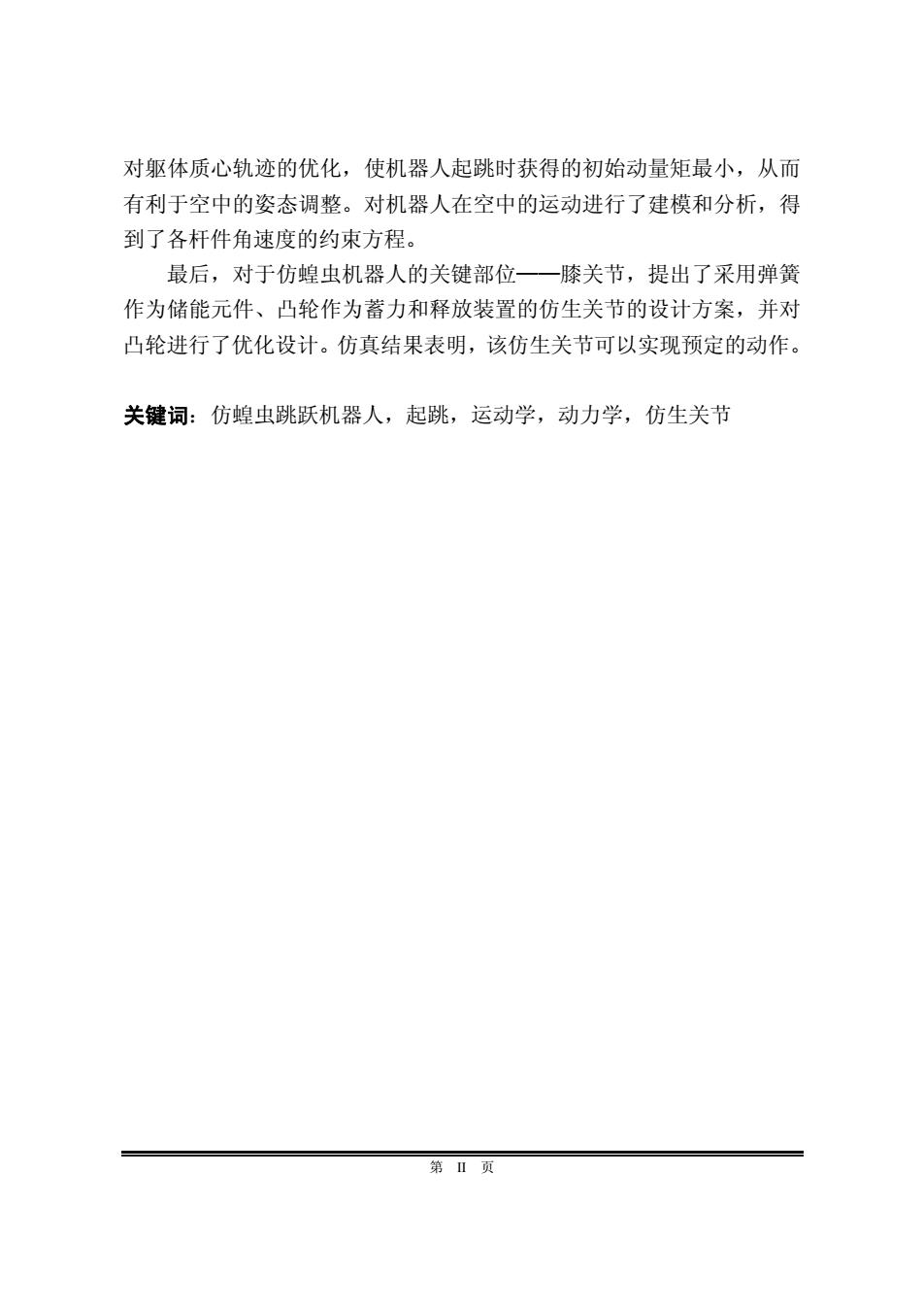
对躯体质心轨迹的优化,使机器人起跳时获得的初始动量矩最小,从而 有利于空中的姿态调整。对机器人在空中的运动进行了建模和分析,得 到了各杆件角速度的约束方程。 最后,对于仿蝗虫机器人的关键部位一一膝关节,提出了采用弹簧 作为储能元件、凸轮作为蓄力和释放装置的仿生关节的设计方案,并对 凸轮进行了优化设计。仿真结果表明,该仿生关节可以实现预定的动作。 关键词:仿蝗虫跳跃机器人,起跳,运动学,动力学,仿生关节 第Ⅱ页
第 II 页 对躯体质心轨迹的优化,使机器人起跳时获得的初始动量矩最小,从而 有利于空中的姿态调整。对机器人在空中的运动进行了建模和分析,得 到了各杆件角速度的约束方程。 最后,对于仿蝗虫机器人的关键部位——膝关节,提出了采用弹簧 作为储能元件、凸轮作为蓄力和释放装置的仿生关节的设计方案,并对 凸轮进行了优化设计。仿真结果表明,该仿生关节可以实现预定的动作。 关键词:仿蝗虫跳跃机器人,起跳,运动学,动力学,仿生关节
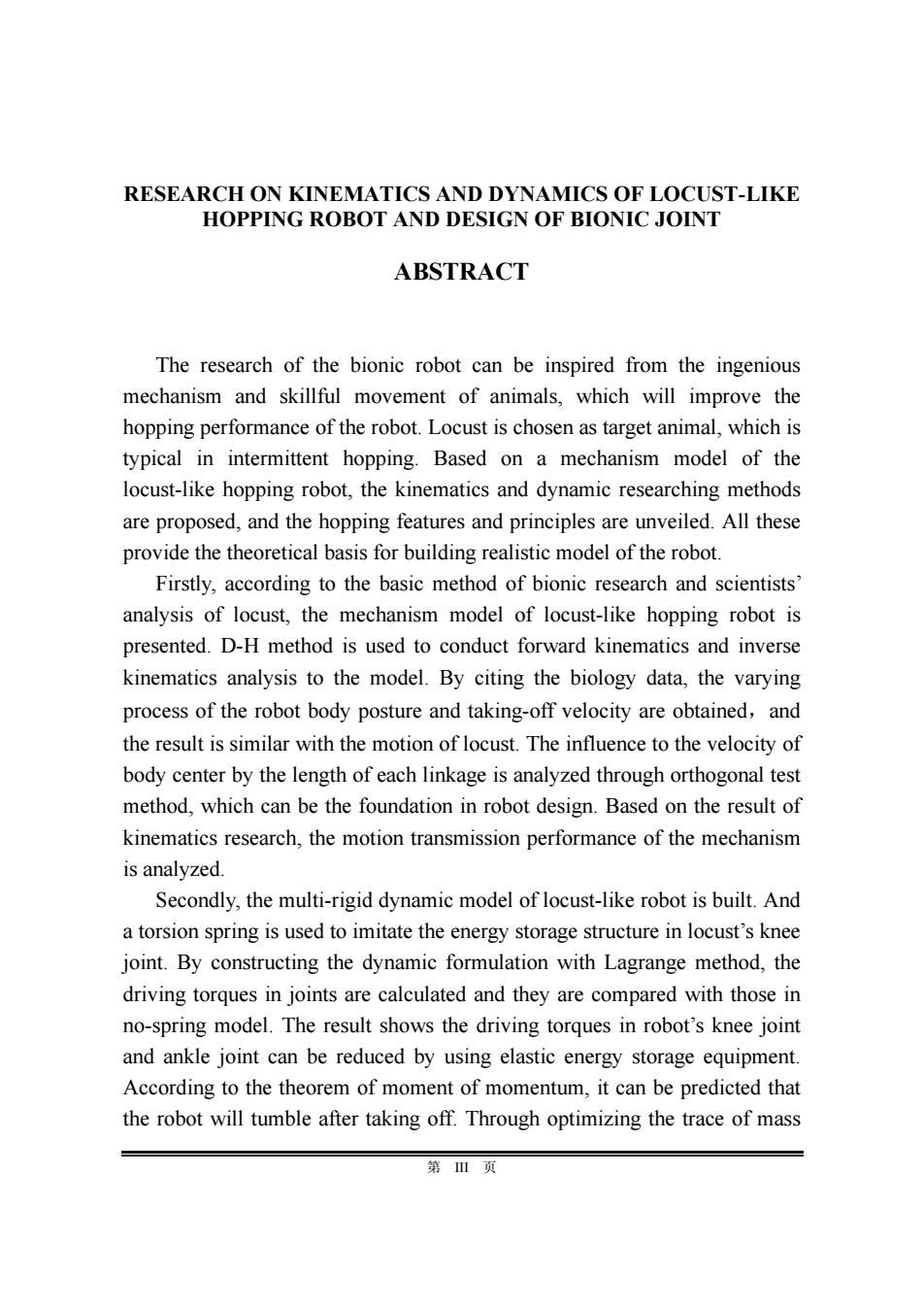
RESEARCH ON KINEMATICS AND DYNAMICS OF LOCUST-LIKE HOPPING ROBOT AND DESIGN OF BIONIC JOINT ABSTRACT The research of the bionic robot can be inspired from the ingenious mechanism and skillful movement of animals,which will improve the hopping performance of the robot.Locust is chosen as target animal,which is typical in intermittent hopping.Based on a mechanism model of the locust-like hopping robot,the kinematics and dynamic researching methods are proposed,and the hopping features and principles are unveiled.All these provide the theoretical basis for building realistic model of the robot Firstly,according to the basic method of bionic research and scientists' analysis of locust,the mechanism model of locust-like hopping robot is presented.D-H method is used to conduct forward kinematics and inverse kinematics analysis to the model.By citing the biology data,the varying process of the robot body posture and taking-off velocity are obtained,and the result is similar with the motion of locust.The influence to the velocity of body center by the length of each linkage is analyzed through orthogonal test method,which can be the foundation in robot design.Based on the result of kinematics research,the motion transmission performance of the mechanism is analyzed. Secondly,the multi-rigid dynamic model of locust-like robot is built.And a torsion spring is used to imitate the energy storage structure in locust's knee joint.By constructing the dynamic formulation with Lagrange method,the driving torques in joints are calculated and they are compared with those in no-spring model.The result shows the driving torques in robot's knee joint and ankle joint can be reduced by using elastic energy storage equipment. According to the theorem of moment of momentum,it can be predicted that the robot will tumble after taking off.Through optimizing the trace of mass 第Ⅲ页
第 III 页 RESEARCH ON KINEMATICS AND DYNAMICS OF LOCUST-LIKE HOPPING ROBOT AND DESIGN OF BIONIC JOINT ABSTRACT The research of the bionic robot can be inspired from the ingenious mechanism and skillful movement of animals, which will improve the hopping performance of the robot. Locust is chosen as target animal, which is typical in intermittent hopping. Based on a mechanism model of the locust-like hopping robot, the kinematics and dynamic researching methods are proposed, and the hopping features and principles are unveiled. All these provide the theoretical basis for building realistic model of the robot. Firstly, according to the basic method of bionic research and scientists’ analysis of locust, the mechanism model of locust-like hopping robot is presented. D-H method is used to conduct forward kinematics and inverse kinematics analysis to the model. By citing the biology data, the varying process of the robot body posture and taking-off velocity are obtained,and the result is similar with the motion of locust. The influence to the velocity of body center by the length of each linkage is analyzed through orthogonal test method, which can be the foundation in robot design. Based on the result of kinematics research, the motion transmission performance of the mechanism is analyzed. Secondly, the multi-rigid dynamic model of locust-like robot is built. And a torsion spring is used to imitate the energy storage structure in locust’s knee joint. By constructing the dynamic formulation with Lagrange method, the driving torques in joints are calculated and they are compared with those in no-spring model. The result shows the driving torques in robot’s knee joint and ankle joint can be reduced by using elastic energy storage equipment. According to the theorem of moment of momentum, it can be predicted that the robot will tumble after taking off. Through optimizing the trace of mass